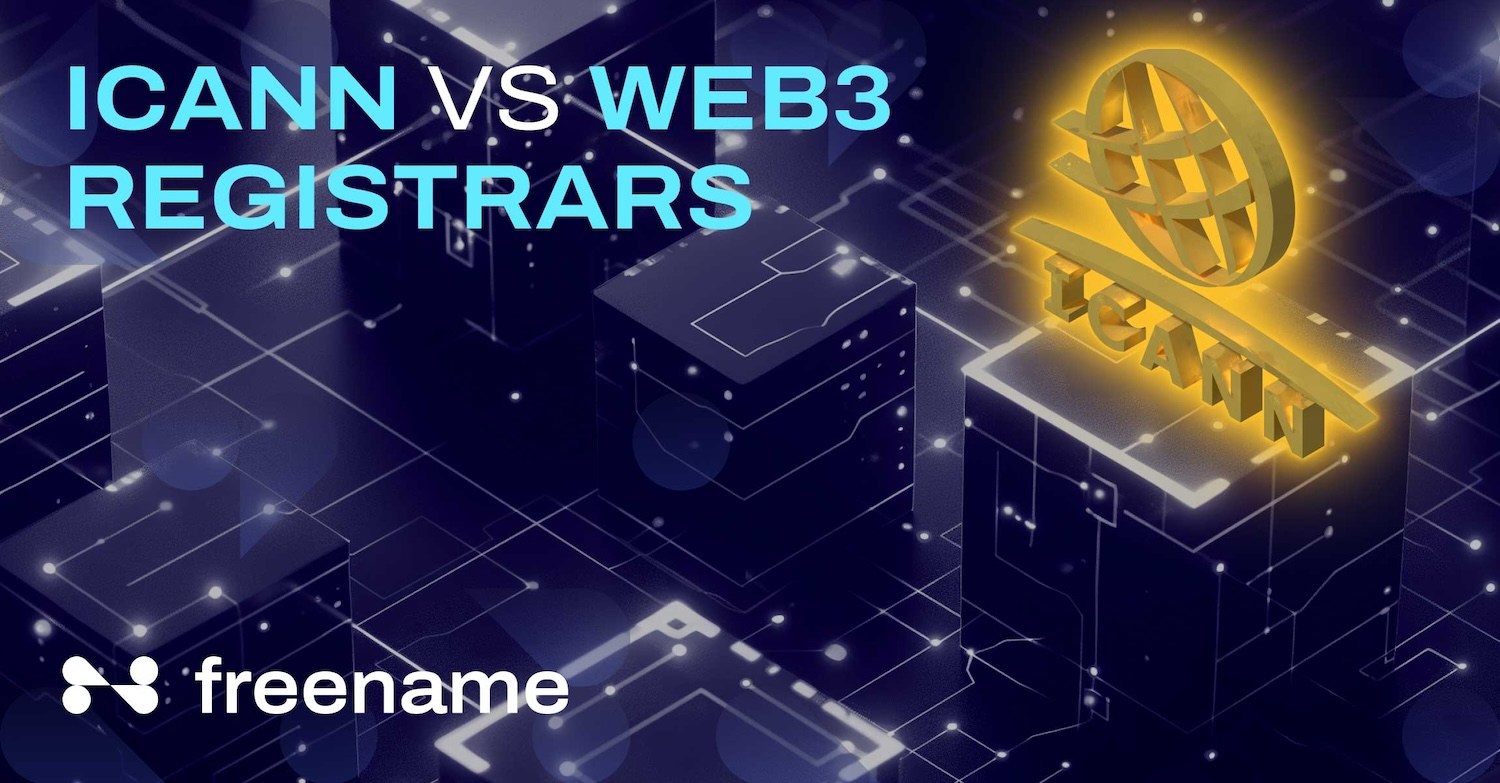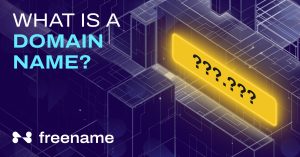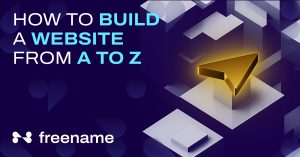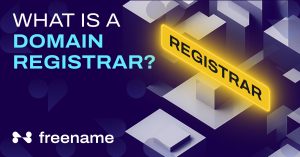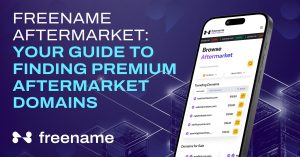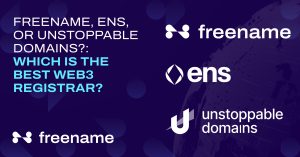ICANN vs. Web3 Registrars
In the early 2000s, websites and portals with interactive features emerged on the horizon. This was the era of the social web, or Web2, dominated by centralized platforms and online collaboration tools. Years later, Gavin Wood coined the term Web3, indicating the internet’s yet another transformation focused on decentralization, digital ownership, tokenomics, and enhanced security.
Web3 refers to an online ecosystem powered by blockchain technology. It addresses vulnerabilities in the Web2 space and promises advanced, user-centric, and scalable solutions. To acquire these advantages for your business, you need a registered domain from a reliable domain registrar.
Choosing the right domain registrar is important because it affects the quality of the domain, its future value, and the potential to attract visitors to your web store. You can either choose an ICANN-accredited registrar or a reliable Web3 registrar.
In our ICANN vs. Web3 Registrar Comparison, we’ll discuss what ICANN is and how it is collaborating with top-tier Web3 registrars to shape the internet.
Understanding ICANN
The Internet Corporation for Assigned Names and Numbers (ICANN) is responsible for simple and smooth domain naming across the web. It coordinates the internet’s unique identifiers, ensuring smooth and secure operations.
Role and Responsibilities
The non-profit organization ensures smooth global internet interoperability by:
- Managing IP address allocation
- Overseeing the domain name system (DNS)
- Accrediting domain name registers
- Defining policies and guidelines to run the internet’s “name and number” system.
ICANN’s Domain Name Management
You must be wondering how ICANN manages domain names and DNS. It does so by coordinating domain name assignments through the internet’s underlying address book, DNS, and registrars. The goal is to ensure each name stays unique.
ICANN also manages the root name servers present in the root zones of the DNS. It administers:
- Generic top-level domains (gTLDs)
- Country code top-level domains (ccTLDs)
These servers translate domain names into IP addresses so that computing devices can identify each other on the network.
TLDs (Top-Level Domains) and Their Significance
ICANN oversees the administration of top-level domains (TLDs), such as .com, .org, and .net, to ensure systematic domain name allocation. These TLDs are divided into different categories depending on location or type.
For example:
- .com TLD is recommended for commercial use
- .net TLD is best suited for networks or communities
- .us or .uk are location-based TLDs representing the USA and UK, respectively
Registering your domain with a reputable TLD can benefit you in many ways. A reputable TLD adds reliability to a business. For example, the .com TLD has the highest trust rating. Although TLD is not a ranking factor, it can impact your SEO efforts.
Web3 Registrars and Their Advantages
ICANN-accredited registrars are reliable but may charge high fees for their services. So, startups with tight budgets—or businesses that have yet to acquire a domain—can contact Web3 registrars and enjoy the following benefits:
Decentralization
Unlike traditional registrars that rely on central DNS, Web3 registrars function on blockchain networks. For example, Freename offers Web3 domain registration services on BASE, Solana, Aurora, and others.
What’s noteworthy is that Web3 registrars eliminate the need for central authorities. Decentralized networks offer a more resilient domain registration system, which is more secure and censorship-resistant.
Cost Efficiency
Blockchain networks do not have intermediaries or central authorities, so the operational cost of a Web3 domain is lower. This cost-efficiency enables Web3 registrars to charge lower registration fees than traditional domain registrars.
Ownership and Control
Traditional systems give registrars significant control over the domain, but the Web3 environment transfers complete domain ownership to the registrants. The digital ownership of the domain is transferred to the domain owner through smart contracts.
Innovation
The decentralized infrastructure of the Web3 space attracts innovators to build modern applications backed by enhanced security and integration features. These features give your domain better scalability, which is missing in traditional domains.
Comparison: ICANN vs. Web3 Registrars
Below is a detailed comparison between ICANN and Web3 registrars
| Features | ICANN | Web3 Registrars |
| Regulation and Control | Centralized servers | Decentralized networks |
| Scalability and flexibility | Limited new TLDs | Dynamic blockchain growth |
| Costs | High Fees + Renewals | One-time payments |
| Security and Reliability | Centralized security risks | Distributed ledger security |
Regulation and Control
ICANN’s role and responsibilities in managing web domain names make it a central authority in the Web2 space. It also defines rules and regulations to run the domain naming process.
The “bottom-up, consensus-driven, multi-stakeholder model” working style involves multiple stakeholders in decision-making. These stakeholders include all registries, registrars, intellectual property advocates, and representatives of more than 100 governments, among others.
Although the organization takes a democratic approach to regulating the Web2 space, it cannot give users complete control over the data. Moreover, users have to share the ownership of their content with service providers,
In contrast, Web3 registrars operate in a decentralized environment where every blockchain user enjoys equal rights in decision-making. Moreover, Web3 users have complete control over their data (digital assets and other information).
Scalability and Flexibility
ICANN manages all TLDs in the Web2 space. That said, the number of TLDs operating worldwide is small compared to the number of online businesses. This scarcity of TLDs makes the Web2 system rigid and inflexible since new TLDs are less likely to rise to the top.
It’s not because of ICANN; it’s because Web2 stakeholders are not flexible enough to deal with new TLDs. For example, ISPs and Web2 registrars tend to promote the .com TLD, giving the impression that it’s a must-have for every commercial business.
Moreover, Web2 TLDs have a fair share of shortcomings in terms of features, multi-device support, app support and accessibility. Gaming enthusiasts have already highlighted these shortcomings, showing dissatisfaction with traditional verification processes, limited platform accessibility, and the lack of real-time reward accumulation with multi-device access.
On the other hand, Web3 registrars offer scalable and flexible solutions courtesy of blockchain technology. A Web3 game built on the Ethereum blockchain can integrate with thousands of dApps simultaneously. Players can access the game using their domain names from any device.
Costs and Fees
Finding the right domain name can be challenging. Plus, if you find a domain name that matches your brand, be prepared to pay a hefty amount in purchases. In connection, the Web2 domain registration is subject to renewal.
It is worth mentioning here that ICANN oversees domain registration worldwide but cannot regulate domain registration prices. Usually, ICANN-accredited registrars charge on a yearly basis, which means you have to pay the renewal fees every year. The Web2 domain registration price varies between $10 and $20 per year.
On the other hand, Web3 registrars charge one-time registration fees, and the domain is yours forever. There is no need to upgrade your Web3 domain because it will integrate automatically with other dApps or digital assets on-chain.
Security and Reliability
ICANN operates in an environment where central servers store and retrieve data. A single point of failure can halt the entire operation and may result in larger data losses. This also makes the Web2 space vulnerable to cyber attacks.
In this context, ICANN is continuously working to strengthen its DNS security. The organization introduced a comprehensive DNS Security Threat Mitigation Program to help domain registrars counter security issues. They also have a framework in place, anticipating a better and more reliable Web2 DNS system.
Still, there’s a lot to be done to match the distributed ledger security offered by the decentralized internet. Blockchain networks record every transaction in a decentralized ledger. The ledger knows the identity and addresses of every block across the blockchain. Every block has a unique address and is secured by cryptographic encryption.
Freename.io, being a renowned Web3 domain provider and hosting platform, extends its support to ICANN’s efforts in mitigating security-related threats. The goal is to provide Web2 users with the same security and reliability as Web3 users.
The Future of Domain Registrars
The future looks brighter as we just witness a historic collaboration that will likely change the course of the digital ecosystem. ICANN has acknowledged Freename’s active role in shaping the internet, making it the first Web3-ICANN accredited registrar.
Now, Freename.io offers a blend of traditional domain management and Web3 services, accommodating Web2 and Web3 users through a single platform. With Freename’s domain mirroring and tokenization services, Web2 domain users can enjoy the same level of security and convenience as Web3 domain owners.
Moreover, Web3 market trends suggest blockchain and Web3 technologies will continue to gain traction and become mainstream in the coming years. This will increase the scalability of blockchain-powered assets such as cryptocurrency, wallets, NFTs, domains, and other dApps.
There are challenges associated with regulatory framework and technological advancements. Given the increasing demand, we will likely see Web3 regulations and advanced apps with user-friendly features in place by the next couple of years or so.
Conclusion
ICANN is a non-profit organization that manages domain name allocation and regulates traditional TLDs worldwide. It also accredits domain registrars and sets consensus-driven guidelines for smooth and secure registration.
The organization focuses on delivering user-centric results within its capacity, as much as the centralized ecosystem allows. On the other hand, Web3 registrars operate in a decentralized environment, addressing major issues in the Web2 space, such as data security, integrity, privacy, costs, and shared ownership.
So, who would you choose: an ICANN-accredited registrar or a Web3 registrar? Or would you go for a service that offers the best of both worlds? Traditional domain owners can also experience the best features of Web3 using the Freename platform.
Recently, Freename became the first Web3-ICANN accredited registrar, offering domain mirroring and tokenization services to traditional domain owners. Meanwhile, it continues to satisfy its Web3 clientele through a multichain-compatible platform that provides affordable Web3 domains and TLDs. Aspiring entrepreneurs and startups can explore a wide variety of Freename domains that offer permanent ownership with a much higher future value. Moreover, you can become a TLD registrar and earn up to 50% royalties whenever a new second-level domain (SLD)

